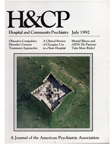Intentional Hyperventilation as a Self-Stimulating Addiction
Abstract
Mr. A's hyperventilation represents the potentially maladaptive ways in which patients obtain gratification. The danger associated with the behavior is seemingly less than that of the drug use it replaced. This trade-off underscores the complexity of the clinician's risk-benefit analysis in determining whether a behavior requires treatment.
Although the patient appeared to have suffered no physiological damage as a result of hyperventilating, his mental status changes and the potential for other changes warranted close observation of this behavior. Electroencephalogram, electrocardiogram, and electrolyte changes, hypoxemia, apnea, and injury from loss of consciousness and falling are all possible sequelae (3,4,6). In addition, like other self-stimulating behaviors performed excessively, voluntary hyperventilation can foster social isolation and alienation, particularly if performed to the exclusion of ordinary daily routines.
Access content
To read the fulltext, please use one of the options below to sign in or purchase access.- Personal login
- Institutional Login
- Sign in via OpenAthens
- Register for access
-
Please login/register if you wish to pair your device and check access availability.
Not a subscriber?
PsychiatryOnline subscription options offer access to the DSM-5 library, books, journals, CME, and patient resources. This all-in-one virtual library provides psychiatrists and mental health professionals with key resources for diagnosis, treatment, research, and professional development.
Need more help? PsychiatryOnline Customer Service may be reached by emailing [email protected] or by calling 800-368-5777 (in the U.S.) or 703-907-7322 (outside the U.S.).



